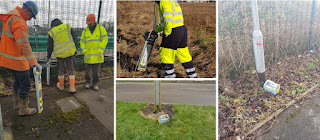One of the most dangerous things
that any construction worker can do is to dig down into the ground without
there first having been a complete and thorough survey of the area by a
competent surveyor using the very latest technology.
The simple fact is that –
wherever you live – there is any number of services that supply your home, your
office, your local high street, and in fact any building that requires
electricity, water, sewage pipes, and more. Certainly, there may be a few barns
out in the country that contains cows or pigs and doesn’t require those
facilities, but most of us do.
In a nutshell, what that means is
that underground cables, water pipes, gas pipes, sewage pipes, telecoms, and
more, can be – and indeed are likely to be – almost anywhere.
All of which means that, if you
work for a contractor as a groundworker, you need to be confident that the area
where you are going to dig is free from underground services. Or more than
likely, if it isn’t, you know exactly where they run and that you won’t
actually strike them when you commence operations because they are six feet
over to the left, or whatever it happens to be.
Read more information Click here

































